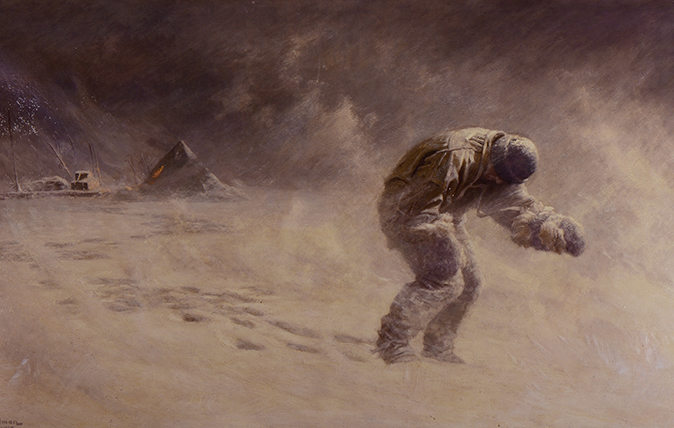My favourite painting: Simon Hart
'For any artist to create such drama and emotion from a scene of almost total whiteout is a great skill.'


A Very Gallant Gentleman, 1913, by John Charles Dollman (1851–1934), 70in by 40in, The Cavalry and Guards Club, London
Simon Hart says: I’ve always been fascinated by feats of human endurance and none could have been more extreme than the race to the Pole, or involved such bravery and tragedy. This picture somehow manages to capture all of that, including the vicious cold and Capt Oates’s eventual recognition that the end had come. For any artist to create such drama and emotion from a scene of almost total whiteout is a great skill. The hint of light in the tent that Capt Oates is leaving behind for the last time only helps underline the bravery of him and his team.
Simon Hart is the Chairman of the Countryside Alliance and MP for Carmarthen West & South Pembrokeshire
John McEwen comments on A Very Gallant Gentleman: From The Last Expedition of Captain Scott (1913): ‘Tuesday, March 6: Poor Oates is unable to pull…his spirits only come up in spurts now, and he grows silent in the tent.’
‘Friday, March 16 or Saturday 17: Poor Titus Oates said he couldn’t go on; he proposed we should leave him in his sleeping-bag. That we could not do... At night he was worse... he woke in the morning—yesterday. It was blowing a blizzard. He said: “I am just going outside and may be some time”... though we tried to dissuade him, we knew it was the act of a brave man and an English gentleman. We all hope to meet the end with a similar spirit.’ Scott and his two surviving companions, Wilson and Bowers, died 12 days later.
Oates had fought (and been recommended for a VC) in the Second Boer War, during which a severe wound made his left leg, worse affected by gangrene and frostbite in Antarctica, shorter than his right. Scott selected him to handle the expedition ponies; the old Etonian Oates also contributed today’s equivalent of £50,000 towards costs.
Oates’s nicknames were ‘Titus’ and ‘The Soldier’. ‘The Soldier takes a gloomy view of everything, but I’ve come to see that this is a characteristic of him,’ wrote Scott. Oates wrote of Scott: ‘It is himself first, the rest nowhere.’
Exquisite houses, the beauty of Nature, and how to get the most from your life, straight to your inbox.
John Charles Dollman was a frequent exhibitor at the royal Academy and a magazine illustrator, said to have been admired by van Gogh. This picture was commissioned by members of Oates’s club, The Cavalry and Guards.
** Read all the articles in our My Favourite Painting series
Country Life is unlike any other magazine: the only glossy weekly on the newsstand and the only magazine that has been guest-edited by His Majesty The King not once, but twice. It is a celebration of modern rural life and all its diverse joys and pleasures — that was first published in Queen Victoria's Diamond Jubilee year. Our eclectic mixture of witty and informative content — from the most up-to-date property news and commentary and a coveted glimpse inside some of the UK's best houses and gardens, to gardening, the arts and interior design, written by experts in their field — still cannot be found in print or online, anywhere else.
